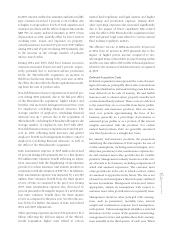American Express 2004 Annual Report Download - page 56
Download and view the complete annual report
Please find page 56 of the 2004 American Express annual report below. You can navigate through the pages in the report by either clicking on the pages listed below, or by using the keyword search tool below to find specific information within the annual report.
Consolidated Balance Sheets. The fair value of the inter-
est-only strip is the present value of estimated future
excess spread expected to be generated by the securi-
tized loans over the estimated life of those loans. Excess
spread, which is the net positive cash flow from interest
and fee collections allocated to the investors’ interests
after deducting the interest paid on investor certificates,
credit losses, contractual servicing fees and other
expenses is recognized in securitization income as it is
earned. As of December 31, 2004 and 2003, the fair
value of the interest-only strip was $207 million and
$225 million, respectively.
In accordance with the Lending Trust agreements, the
excess spread in the Lending Trust is required to be main-
tained at a level greater than 0% at any point in time in
the Lending Trust. As of December 31, 2004, the percent-
age of excess spread was approximately 10%, well in
excess of the minimum requirement.
Under the respective terms of the Lending Trust and the
Charge Trust pooling and servicing agreements, the
occurrence of certain events could result in either trust
being required to paydown the investor certificates
before their expected payment dates over an early
amortization period. Examples of these events include:
©for either trust, the failure of the securitized assets to
generate specified yields over a defined period of time,
©for the Lending Trust, the decline of the total of the
securitized assets’ principal balances below a speci-
fied percentage of total investor amounts outstand-
ing after the failure to add additional securitized
assets as required by the agreement, and
©for the Charge Trust, the decline of the total of the
securitized assets’ principal balances below a speci-
fied percentage of the total principal component.
The Company does not expect an early amortization
trigger event to occur. In the event of a paydown of the
Lending Trust, $20.3 billion of assets would revert to the
balance sheet and an alternate source of funding of a
commensurate amount would have to be obtained. Had
a total paydown of the Lending Trust hypothetically
occurred at a single point in time at December 31, 2004,
the one-time negative effect on results of operations
would have been approximately $800 million pretax to
re-establish reserves and to derecognize the retained
interests related to these securitizations that would have
resulted when the securitized loans reverted back onto
the balance sheet. Subject to the performance of the
loans, the one-time negative effect would be offset by
finance charge revenue over the life of the loans. Virtu-
ally no financial statement impact would occur from a
paydown of the Charge Trust, but an alternate source of
funding for the $1.9 billion of securities outstanding at
December 31, 2004 would have to be obtained.
With respect to both the Lending Trust and the Charge
Trust, a decline in the actual or implied short-term credit
rating of TRS below A-1/P-1 will trigger a requirement
that TRS, as servicer, transfer collections on the securi-
tized assets to investors on a daily, rather than a
monthly, basis or make alternative arrangements with
the rating agencies to allow TRS to continue to transfer
collections on a monthly basis. Such alternative arrange-
ments include obtaining appropriate guarantees for the
performance of the payment and deposit obligations of
TRS, as servicer.
No officer, director or employee holds any equity interest
in the trusts or receives any direct or indirect compensa-
tion from the trusts. The trusts in the Company’s securi-
tization programs do not own stock of the Company or
the stock of any affiliate. Investors in the securities issued
by the trusts have no recourse against the Company if
cash flows generated from the securitized assets are inad-
equate to service the obligations of the trusts.
Liquidity
The Company balances the trade-offs between having
too much liquidity, which can be costly and limit
financial flexibility, with having inadequate liquidity,
which may result in financial distress during a liquidity
event (see Contingent Liquidity Planning section
below). The Company considers various factors in
determining its liquidity needs, such as economic and
financial market conditions, seasonality in business
operations, growth in business segments, cost and avail-
ability of alternative liquidity sources and credit rating
agency considerations.
In 2004, TRS continued to strengthen its liquidity posi-
tion by reducing its reliance on short-term debt, extend-
ing and spreading out its debt maturities and enhancing
the capacity and flexibility of its contingent funding
resources. Short-term debt on a GAAP basis as a per-
centage of total debt declined to 38% at December 31,
2004 from 57% at December 31, 2003. Short-term debt
on a managed basis as a percentage of total debt
declined to 26% at December 31, 2004 from 38% at
December 31, 2003.
TRS estimates it will have funding requirements of
approximately $16 billion within the next year related
to the maturity of medium- and long-term debt obliga-
tions. These requirements include $6.4 billion related to
certain securitization transactions that will enter their
scheduled amortization period. In addition, TRS expects
AXP
AR.04
54
Financial Review
























